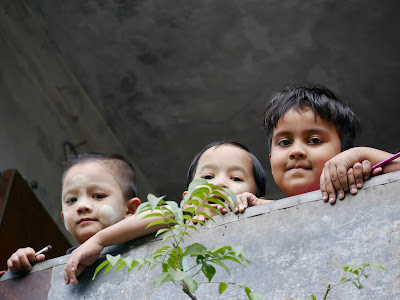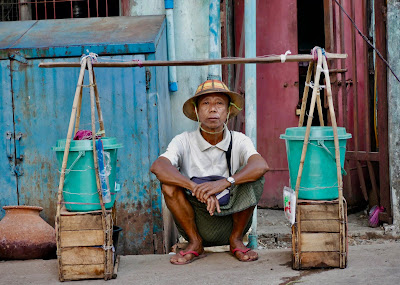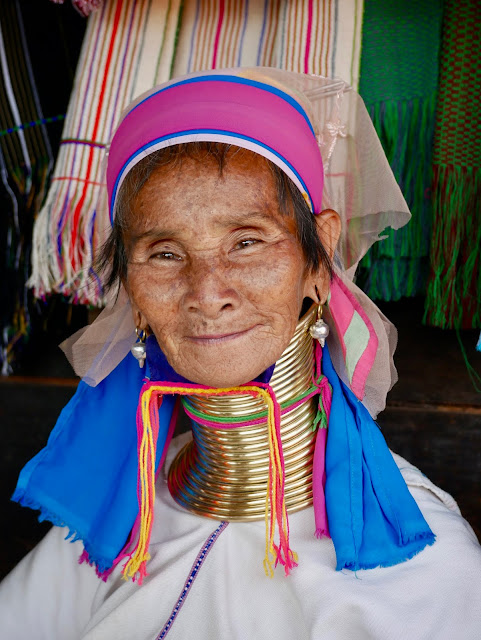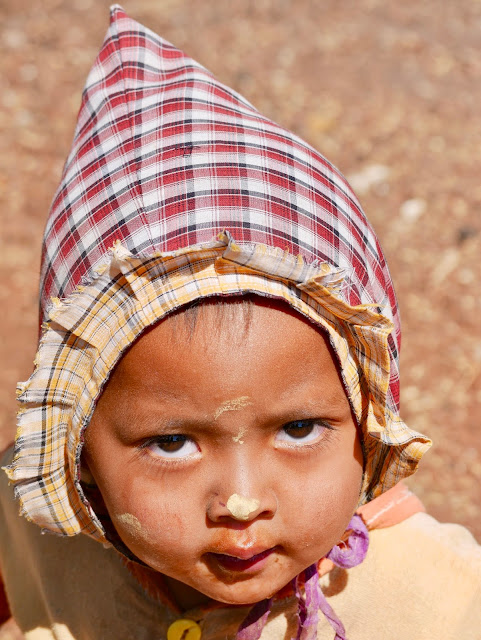Mawlamyine is one of Myanmar's larger cities with a population of around 300,000 people. It was chosen by the British as the first capital of colonial Burma, a status it held between 1826 and 1852 and became an important centre for commerce in the late part of the 20th century. This was in large part due to the arrival significant numbers of Indian merchants and workers. By the late 1880's, they had formed the largest ethnic group in the city living and working alongside Burmans, Chinese, Malays, Armenians and even a handful of Jewish merchants.
During the colonial period, the city was called Moulmein and gained mention in the writings of both George Orwell in Shooting An Elephant and Rudyard Kipling in his poem Mandalay. The streets are lined with some very fine examples of architecture dating from that period although much of it is now crumbling. There are also many buildings that show the strong influence of Indian design, particularly those with wooden facades carved in intricate patterns and of course in the numerous mosques and Hindu temples that can be found across the city. There are also several important churches and pagodas including the spectacular hilltop Seindon Mibaya Kyaung which is under the care of a single, famously grumpy elderly monk. All of this should attract visitors in significant numbers but Mawlamyine does not receive the number of guests that other cities can boast. It is usually seen as a one or at most two nights stay over and a base for visiting other places. As regular readers may expect, I am about to disagree with this.
I spent three days there and realised that this was not enough to see some of the big ticket items but more importantly to explore in detail the cramped, crowded, chaotic back lanes of the city or to exhaust the busy, sprawling markets. Hidden from the main streets and easily missed the lanes are noisy, dirty and sometimes hazardous to walk in yet I was drawn back to them several times. In these hidden alleyways life has not much changed in a hundred years and a warm welcome is given to those who venture into them. Living conditions are challenging and many of the homes have problems with accessing electricity and a regular clean water supply. Many people use the open wells that are scattered around the city, drawing water to wash clothes or to clean the home despite the fact that some of them contain rubbish and in some cases free roaming chickens, ducks and other fowl deposit their droppings in them. New wells are established to serve the demand for water. I witnessed several workers detailed on this work including the one pictured at the top of this post.
Despite this, there is an easy atmosphere in here. People sit outside their houses talking to their friends and neighbours whilst their children play in the street. They are curious about visitors as not many venture off the main tourist trail of churches, temples, mosques and pagodas. It is amazing how much goodwill a simple "Mingalabar" (hello in Myanmar) can win for you and how quickly it will be followed up with questions about where you come from, what your work is and where are your family. This is often accompanied by offers of tea or snacks, reminding me of the warmth of the people living in the lanes of North Kolkata.
Despite this, there is an easy atmosphere in here. People sit outside their houses talking to their friends and neighbours whilst their children play in the street. They are curious about visitors as not many venture off the main tourist trail of churches, temples, mosques and pagodas. It is amazing how much goodwill a simple "Mingalabar" (hello in Myanmar) can win for you and how quickly it will be followed up with questions about where you come from, what your work is and where are your family. This is often accompanied by offers of tea or snacks, reminding me of the warmth of the people living in the lanes of North Kolkata.
In one of the lanes I noticed an elderly man crouched on the floor and using a hammer to work on a sheet of metal. Abdul is 87 years old. In fact it happened to be his birthday on the day I met him. He is a little deaf and one of his daughters came across to help us communicate. Despite being retired, Abdul likes to keep busy and he makes metal boxes to earn a little money. He confessed that he has few customers these days but he still enjoys working. His daughter was holding one of his grandchildren. I asked him how many he had. He wasn't sure and said "I have grandchildren and great grandchildren. About 20 I think". He stood for a picture, proudly holding one of the twenty.
In the same alley I noticed three small children looking down from a first floor balcony. Others were arriving at the building carrying satchels and books. It was too late in the afternoon for them to be going to school and I asked a woman standing outside the building what was happening. She explained that children came here after school for private tuition. Competition for jobs is very tough in Myanmar and parents who can afford it send their children to these places in order to improve their chances. Many children do not get the chance to complete their formal education as the family needs them to work and help pay for food and a place to live. How humbling that parents in one of Mawlamyine's poorest neighbourhoods had prioritised education and the hope of a better future. At the same time other, poorly dressed children played in the alley amongst bags of cement. We sometimes forget how fortunate we are.
A little further on I met U Aung Khaing, also 87 years old. He was born in Kayin state but is from the Mon ethnic group, once rulers of a mighty empire and the predominant group in Mon State of which Mawlamyine is a part. They are now numerically in decline, to some extent due to inter-marriage with other groups. The Mon language is also in danger and work is being done in local schools to preserve it. Each ethnic group in Myanmar has its own customs and dress and U Aung Khaing was wearing the red lungyi of the Mon.
As in India, drinking tea is a bit of a national pastime in Myanmar and there are teashops on every corner. I met Maulana sitting outside of of one of them. I was struck by his appearance, particularly by his wearing of a Pashtun cap, usually associated with Afghanistan and Pakistan and an unusual sight in Myanmar. I was keen to photograph him and was a little surprised when he immediately and enthusiastically agreed. He told me that he understands Urdu as well as Myanmar and invited me to sit and take tea for a while. A woman wearing the hijab sat at the next table and helped translate for us. I realised that she was his wife. It would be interesting to know more about their story.
In another lane I spotted a small shop with two sides open to the street. The customers were mainly elderly Chinese men. Myanmar has a significant Chinese minority and Yangon has a vibrant Chinatown. I stopped to talk to the two old men sitting in a corner facing the street and asked them if the tea was good. They told me that it was and that it was the best tea shop in Mawlamyine. I asked if they come every day and one of them confirmed that he did. I also asked about the name of the shop but was told it is nameless. A few minutes later his friend told me that the man who came every day was the owner. That might explain the regularity of his visits and the claim to it being the best tea shop in town. I haven't tried them all so I can't say.
As well as the ubiquitous tea shops, the city streets are filled with vendors offering various delights. In the lanes I came across a man selling tamarind from two containers held together on a yoke, allowing him to operate a "mobile" service and a woman selling thick, sticky jams from a street corner stall. And then there are the city's two large markets offer fruit, vegetables, meat, fish, huge bags of rice and salt, spices, household goods, electrical items.clothes, children's toys and more. Most of the vendors and shoppers are women. Shopping is a serious business here and it is educational to stand back and watch the expert hagglers reduce the price of a cauliflower using perfectly honed methods - cajoling, scowling, smiling and pretending to walk away before the deal is secured.
In the Lower Market, I met the utterly charming Tin Ohn. Aged 67, he was born in Hpa An but his family fled to Mawlamyine when he was a child due to a period of inter-communal strife. He has never married and used the English word "Batchelor" to describe himself and also his two sisters who share a home with him. He is one of seven siblings, three of whom have already died. He spoke affectionately about his school days when he studied at an English medium Catholic school. He recalled the priests being strict disciplinarians "to drop litter was a very serious matter, we even had to be careful with the shavings from sharpening our pencils. Not like today". He especially remembered Father Francis who he said was a very good teacher. Tin makes his living by selling metal boxes but says that business is not so good these days. The family originally came from India but he does not know exactly where. His Indian name is Nadul Chowdhury which may (or may not) indicate that they came from Bengal.
I thought about this conversation a little later the same day. Away from the markets and the lanes and whilst admiring the city's largest mosque, I saw a small boy eating pieces of fruit from a plastic bag whilst maintaining a serious expression. "What are you eating" my friend asked him. "Pineapple" he replied. "Sour or sweet" we asked. "Sour. I like sour" he said. "Why aren't you at school?" I asked him. "I don't live here. I'm visiting" he replied. "Does your teacher know?" I asked. "No" he said and laughed. I felt sure Father Francis would not have approved.
| The pineapple boy |
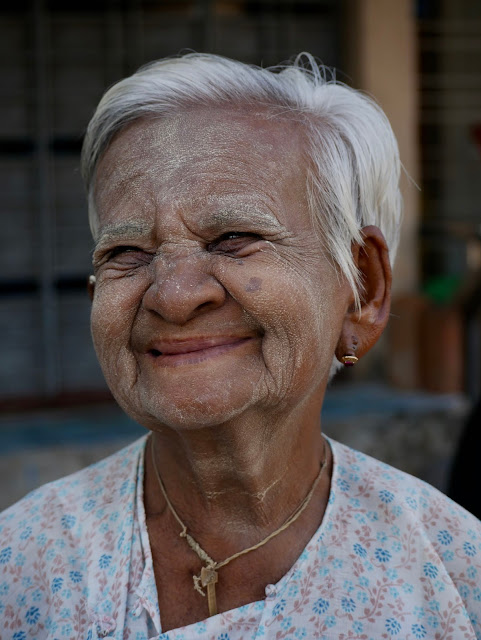 |
| A welcome smile |
I look forward to returning to Mawlamyine before too long, to spend more time in the lanes and the markets, to test the theory of the best tea shop, to admire the eclectic architecture and to hear more stories of its friendly citizens. And perhaps to again meet the lovely friendly lady pictured above, one of the first people I met on arrival in the city and who welcomed me with her wonderful smile.
You might also like Meeting The Kayan Women Of Myanmar.
You can see more pictures from Myanmar here.






